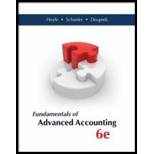
Fundamentals of Advanced Accounting
6th Edition
ISBN: 9780077862237
Author: Joe Ben Hoyle, Thomas Schaefer, Timothy Doupnik
Publisher: McGraw-Hill Education
expand_more
expand_more
format_list_bulleted
Textbook Question
Chapter 4, Problem 2Q
Atwater Company acquires 80 percent of the outstanding voting stock of Belwood Company. On that date, Belwood possesses a building with a $160,000 book value but a $220,000 fair value. At what value would this building be consolidated?
Expert Solution & Answer
Want to see the full answer?
Check out a sample textbook solution
Students have asked these similar questions
Suppose you take out a five-year car loan for $14000, paying an annual interest rate of 4%. You make
monthly payments of $258 for this loan.
Complete the table below as you pay off the loan.
Months
Amount still owed
4% Interest on
amount still owed
(Remember to divide
by 12 for monthly
interest)
Amount of monthly
payment that goes
toward paying off the
loan (after paying
interest)
0
14000
1
2
3
+
LO
5
6
7
8
9
10
10
11
12
What is the total amount paid in interest over this first year of the loan?
Suppose you take out a five-year car loan
for $12000, paying an annual interest rate
of 3%. You make monthly payments of $216
for this loan.
mocars
Getting started (month 0): Here is how the process works. When you buy the car, right at month 0, you owe
the full $12000. Applying the 3% interest to this (3% is "3 per $100" or "0.03 per $1"), you would owe
0.03*$12000 = $360 for the year. Since this is a monthly loan, we divide this by 12 to find the interest
payment of $30 for the month. You pay $216 for the month, so $30 of your payment goes toward interest
(and is never seen again...), and (216-30) = $186 pays down your loan.
(Month 1): You just paid down $186 off your loan, so you now owe $11814 for the car. Using a similar
process, you would owe 0.03* $11814 = $354.42 for the year, so (dividing by 12), you owe $29.54 in interest
for the month. This means that of your $216 monthly payment, $29.54 goes toward interest and $186.46
pays down your loan.
The values from above are included…
Suppose you have an investment account that earns an annual 9% interest rate, compounded monthly. It
took $500 to open the account, so your opening balance is $500. You choose to make fixed monthly
payments of $230 to the account each month.
Complete the table below to track your savings growth.
Months
Amount in account (Principal)
9% Interest
gained
(Remember to
divide by 12 for
monthly interest)
Monthly Payment
1
2
3
$500
$230
$230
$230
$230
+
$230
$230
10
6
$230
$230
8
9
$230
$230
10
$230
11
$230
12
What is the total amount gained in interest over this first year of this investment plan?
Chapter 4 Solutions
Fundamentals of Advanced Accounting
Ch. 4 - Prob. 1QCh. 4 - Atwater Company acquires 80 percent of the...Ch. 4 - What is a control premium and how does it affect...Ch. 4 - Prob. 4QCh. 4 - How is the noncontrolling interest in a subsidiary...Ch. 4 - Prob. 6QCh. 4 - Prob. 7QCh. 4 - Prob. 8QCh. 4 - Prob. 9QCh. 4 - Prob. 10Q
Ch. 4 - Prob. 1PCh. 4 - Prob. 2PCh. 4 - Prob. 3PCh. 4 - Prob. 4PCh. 4 - Prob. 5PCh. 4 - Prob. 6PCh. 4 - Prob. 7PCh. 4 - Prob. 8PCh. 4 - Prob. 9PCh. 4 - Prob. 10PCh. 4 - Prob. 11PCh. 4 - Prob. 12PCh. 4 - Prob. 13PCh. 4 - Prob. 14PCh. 4 - Prob. 15PCh. 4 - Prob. 16PCh. 4 - Prob. 17PCh. 4 - Prob. 18PCh. 4 - Current liabilities: a. 50,000 b. 46,000 c. 40,000...Ch. 4 - Prob. 20PCh. 4 - Stockholders equity: a. 80,000 b. 90,000 c. 95,000...Ch. 4 - Prob. 22PCh. 4 - Prob. 23PCh. 4 - Prob. 24PCh. 4 - Prob. 25PCh. 4 - Prob. 26PCh. 4 - Prob. 27PCh. 4 - Prob. 28PCh. 4 - Prob. 29PCh. 4 - Prob. 30PCh. 4 - Prob. 31PCh. 4 - Prob. 32PCh. 4 - Prob. 33PCh. 4 - Prob. 34PCh. 4 - Prob. 35PCh. 4 - Prob. 36PCh. 4 - Prob. 37PCh. 4 - Prob. 38PCh. 4 - Prob. 39PCh. 4 - Prob. 40PCh. 4 - Prob. 41PCh. 4 - Prob. 42PCh. 4 - Prob. 1DYS
Knowledge Booster
Learn more about
Need a deep-dive on the concept behind this application? Look no further. Learn more about this topic, accounting and related others by exploring similar questions and additional content below.Similar questions
- Hii expert please given correct answer general Accounting questionarrow_forwardOn 1st May, 2024 you are engaged to audit the financial statement of Giant Pharmacy for the period ending 30th December 2023. The Pharmacy is located at Mgeni Nani at the outskirts of Mtoni Kijichi in Dar es Salaam City. Materiality is judged to be TZS. 200,000/=. During the audit you found that all tests produced clean results. As a matter of procedures you drafted an audit report with an unmodified opinion to be signed by the engagement partner. The audit partner reviewed your file in October, 2024 and concluded that your audit complied with all requirements of the international standards on auditing and that; sufficient appropriate audit evidence was in the file to support a clean audit opinion. Subsequently, an audit report with an unmodified opinion was issued on 1st November, 2024. On 18th January 2025, you receive a letter from Dr. Fatma Shemweta, the Executive Director of the pharmacy informing you that their cashier who has just absconded has been arrested in Kigoma with TZS.…arrow_forwardNonearrow_forward
arrow_back_ios
SEE MORE QUESTIONS
arrow_forward_ios
Recommended textbooks for you



What is liquidity?; Author: The Finance Storyteller;https://www.youtube.com/watch?v=XtjS7CfUSsA;License: Standard Youtube License